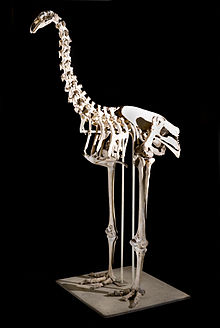Our website is made possible by displaying online advertisements to our visitors.
Please consider supporting us by disabling your ad blocker.
South Island giant moa
| South Island giant moa Temporal range: Late Holocene
| |
|---|---|

| |
| Skeleton, likely of an adult male | |
| Scientific classification | |
| Domain: | Eukaryota |
| Kingdom: | Animalia |
| Phylum: | Chordata |
| Class: | Aves |
| Infraclass: | Palaeognathae |
| Order: | †Dinornithiformes |
| Family: | †Dinornithidae |
| Genus: | †Dinornis |
| Species: | †D. robustus
|
| Binomial name | |
| †Dinornis robustus | |
| Synonyms | |
|
List
| |
The South Island giant moa (Dinornis robustus) is an extinct species of moa in the genus Dinornis, known in Māori by the name moa nunui.[2] It was one of the tallest-known bird species to walk the Earth, exceeded in weight only by the heavier but shorter elephant bird of Madagascar (also extinct).[citation needed]
- ^ Gill, B.J.; Bell, B.D.; Chambers, G.K.; Medway, D.G.; Palma, R.L.; Scofield, R.P.; et al. (2010). Checklist of the Birds of New Zealand, Norfolk and Macquarie Islands, and the Ross Dependency, Antarctica (PDF) (Report) (4th ed.). Ornithological Society of New Zealand / Te Papa Press. Retrieved 30 October 2022 – via nzbirdsonline.org.nz.
- ^ Doyle, Trent (15 November 2023). "Scientists reveal fossilised moa footprints in Otago are at least 3.6 million years old". Newshub. Archived from the original on 15 November 2023. Retrieved 23 February 2024.
Previous Page Next Page


